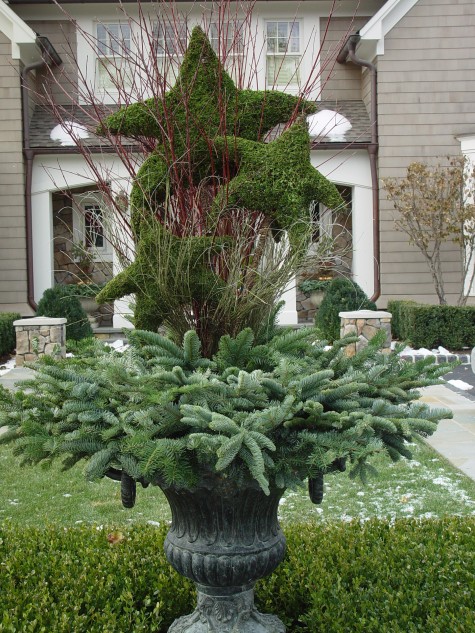I have finally resigned myself to the fact that one of my Princeton Gold maples will not recover. In obvious trouble for the past several years, I tried a number of remedies – aerating the soil, adding compost, careful watering, soil testing, spraying for fungus-none of this made a dent in its decline. In the beginning, I believed I could intervene; after all, I have 13 other maples that are thriving. Undeterred by the fact that it could not tell me where it hurt, I was sure I could, and would, figure it out. In time, this belief that I could set all to right turned to exasperation; nothing was working. When it was clear my homeowner efforts were going no where, I asked Westside Forestry to step in; surely they could fix the problem. All of Tim’s years of experience as an arborist proved as irrelevant as my insistent belief that this tree would grow for me. I will admit that at one point I walked up to this tree, and gave it a swift kick in the trunk; my exasperation had turned to hopping mad. A stand of beech ferns and helleborus angustifolia that had taken every bit of six years to get good would be laid to waste getting that tree out of the ground. Finally resigned to my failure, I have a replacement tree, ready to plant. Not that I could stand to be there and watch when the exchange is made; I do not have that kind of grace in the face of defeat.
In retrospect, I think what proved to be the downfall of this tree was a constellation of events. Not this disease, or that bug, but lots of smaller problems which in the end, in concert, proved overwhelming. Perhaps the rootball was damaged at planting, and maybe it was planted a little too high. Perhaps the extra water, and the mulch I put over the ball, hoping to compensate for that too high planting, rotted roots. Like a daily interest rate, my mistakes started compounding. Pruning the top branches away from the electric line perhaps exposed the trunk to sun scald, and a stressed tree to yet more insult. Lots of little things have a way of picking up speed, volume, and mass; the resulting bits of trouble get to be an event with a life of its own.
Watching my garden fall down around me in high winds, or my cedars flattened by ice, or my hostas riddled with hail bullets-this kind of trouble is every day, ordinary garden trouble, over which I have no control, and eventually get over. When I gloss over or ignore a problem as if it will resolve on its own-this is trouble that belongs to me. I am lucky that the plants in my garden have an innate will to live; more than just a few suffer my bad moves, and survive in spite of me. This why I so treasure anything that volunteers in my garden. They get it right from the beginning. A seed will not germinate until all the conditions it needs to survive are in place. A favorable constellation of events makes for better than even odds that the seed will survive its most vulnerable moment. Seeds are coated in all manner of armor, designed to preserve its viability until conditions are friendly to opening the door, and venturing forth. Such is my fondness and respect for the volunteers in my garden; they are programmed to stay dormant until all the stars are in proper alignment-no exceptions. Then they grow for broke. The nicotiana I grow from seed are always stretched, pallid in color, and hesitant to grow. The wrong choice of soil, the wrong light, the wrong temperature, the wrong water-all of these little things I either ignore or respond too late to, make for horticultural disaster. There have been more than a few times I have deserved a ticket with at least 3 points attached, and a stiff fine. The nicotiana that self sows in the expansion joints of my sidewalk grows lustily, free of my poor excuse for care or erroneous assumptions about what constitutes nurturing.
I had a lengthy discussion with a client of the shop this week, over an antique Victorian era urn she had purchased over a year ago. She said she had never been able to get anything to grow in it. Given that the urn had not ever provided her with a successful planting, much less any fun, she wanted to return or exchange it for another container. Her assertion that the container was responsible for her lack of success left me speechless-where on earth could that idea be coming from? She went on to tell me that she was not an expert gardener; she simply went to the nursery, she bought whatever appealed to her, and planted her pots. This approach, which did not include pairing shade plants with pots in the shade, and sun loving plants in containers placed in sunny locations, had always worked for her. The urn, situated close to the north facing wall of her home, was refusing to grow her a good stand of petunias. The combination of her naivete and arrogance took my breath away; I kept digging.
She finally admitted to noticing that the soil in the pot was always boggy. Victorian urns were frequently made with a bottom reservoir to hold drainage water well away from the roots in the soil. Slits in the sides of bottom bowl would permit water to escape, once it reached the overflow level. As this is not a particularly efficient or thorough way to drain soil; Rob had drilled a hole in the bottom. I asked what material she was using for drainage. After a quizzical look, she told me the urn was too shallow to permit any drainage material; the urn was filled bottom to top with soil. Her decision to skip the drainage material-deadly. There was no placating her with information. She had no interest in hearing that annual plants do not root deeply, nor did she believe that petunias would not tolerate heavy shade and water logged soil. She brushed off my discussion of conditions as though none of that applied to her. I finally told her she bought an urn from my shop, not an urn programmed and magically endowed by me with all the gardening skills necessary to make something grow beautifully. I told her I would not take the urn back, but that I would coach her in the spring about soil, drainage material and plant selection. This was not so much the outcome she expected or wanted, but I could tell she couldn’t help but think about it. We’ll see if she takes ownership of her own trouble, and comes back in the spring.
I have on occasion been so like her. But I have every opportunity to be a better gardener come tomorrow- should I decide to take that on.
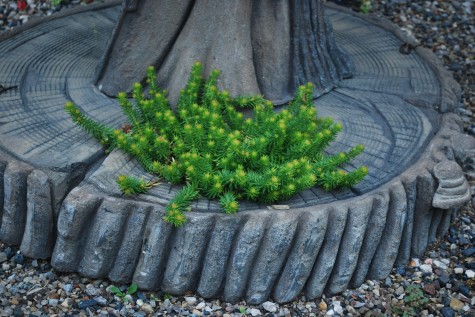
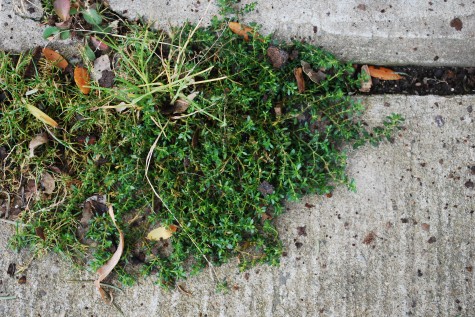
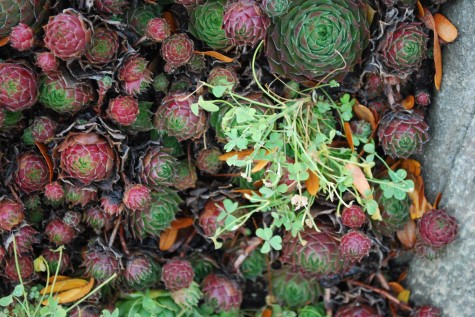






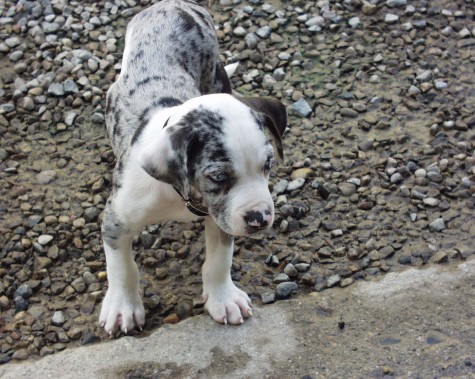
 Troy is a gardener of exceptional ability, in addition to his gift as a sculptor. Growing up on a farm on the west side of Michigan, he grew a giant vegetable garden, ran a blueberry farm, did surveying, hunted, fished, and walked the woods. He came by his skills as a naturalist, naturally. He sculpted for me in concrete; this two-headed fox bench is his work. Annie went everywhere with him, including to the studio.
Troy is a gardener of exceptional ability, in addition to his gift as a sculptor. Growing up on a farm on the west side of Michigan, he grew a giant vegetable garden, ran a blueberry farm, did surveying, hunted, fished, and walked the woods. He came by his skills as a naturalist, naturally. He sculpted for me in concrete; this two-headed fox bench is his work. Annie went everywhere with him, including to the studio. 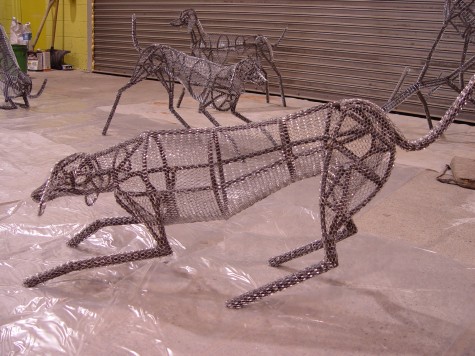
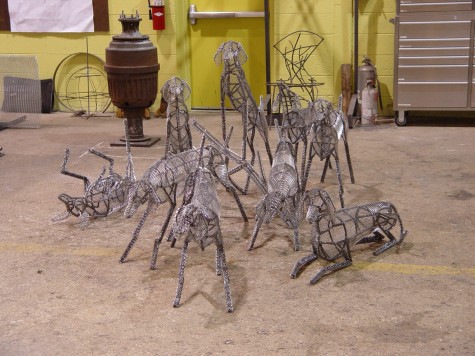 These very gestural and simple structures provide strength for the concrete and mortar to come. He squishes and packs concrete around these frames; the strength that a garden sculpture needs first and foremost, comes first. But I could tell from these frames I was going to like what came next. The outside mortar layer he hand carves.
These very gestural and simple structures provide strength for the concrete and mortar to come. He squishes and packs concrete around these frames; the strength that a garden sculpture needs first and foremost, comes first. But I could tell from these frames I was going to like what came next. The outside mortar layer he hand carves. 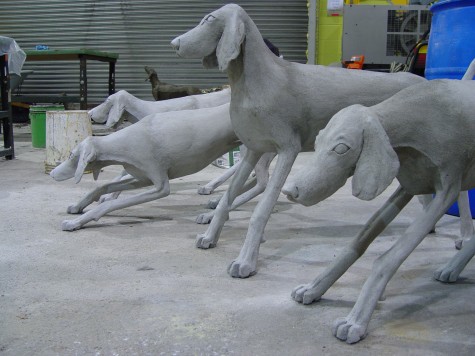 I was not prepared for how much I liked them. His sculptures of hounds are not about a biologically correct reproduction, they are about the heart and soul of his hound Annie. I was astonished by how much energy, motion and fluidity he managed to wring from a marriage of steel, and hundred pound sacks of concrete. This explication aside, these hounds won me over.
I was not prepared for how much I liked them. His sculptures of hounds are not about a biologically correct reproduction, they are about the heart and soul of his hound Annie. I was astonished by how much energy, motion and fluidity he managed to wring from a marriage of steel, and hundred pound sacks of concrete. This explication aside, these hounds won me over.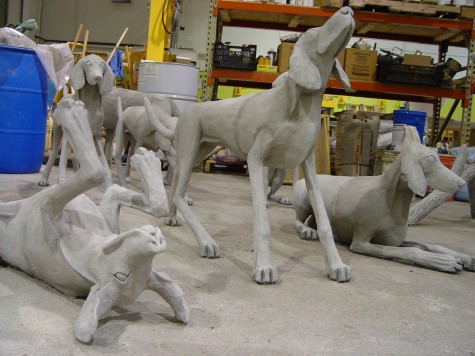 One hound was on his back, sunning and scratching, in the garden. Another was howling at the moon as if he had ten minutes to live. Yet another was tentatively down, those back legs were tucked under in such a position he could be cruising at a second’s notice.
One hound was on his back, sunning and scratching, in the garden. Another was howling at the moon as if he had ten minutes to live. Yet another was tentatively down, those back legs were tucked under in such a position he could be cruising at a second’s notice. This sculpture makes clear the legs that make for balance, and the legs that carry the weight. The position of the ears suggest this hound just shook his head, and looked up towards the moon. Most garden sculpture leaves me cold; these hounds are right at home in a landscape.
This sculpture makes clear the legs that make for balance, and the legs that carry the weight. The position of the ears suggest this hound just shook his head, and looked up towards the moon. Most garden sculpture leaves me cold; these hounds are right at home in a landscape. There was some discussion with Troy regarding sculpture that relies on the environment to be complete. He said, “don’t give me the history, just tell me what you need”. So ok fine, I asked him for a hound barking up a tree-the tree would be supplied by whomever took this barking dog home. She does have a good tree, and this hound has a good home.
There was some discussion with Troy regarding sculpture that relies on the environment to be complete. He said, “don’t give me the history, just tell me what you need”. So ok fine, I asked him for a hound barking up a tree-the tree would be supplied by whomever took this barking dog home. She does have a good tree, and this hound has a good home. 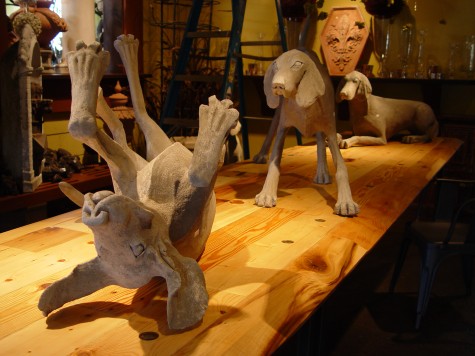 Troy’s sculptures of hounds could be in or out, up or down, on a sidewalk, in a bed, on a wall. I have placed 16 of them; they all moved away from me. When the garden wanes, I think about how much I value the sculpture that enchants me, all year long. His sculpture-creature comfort.
Troy’s sculptures of hounds could be in or out, up or down, on a sidewalk, in a bed, on a wall. I have placed 16 of them; they all moved away from me. When the garden wanes, I think about how much I value the sculpture that enchants me, all year long. His sculpture-creature comfort.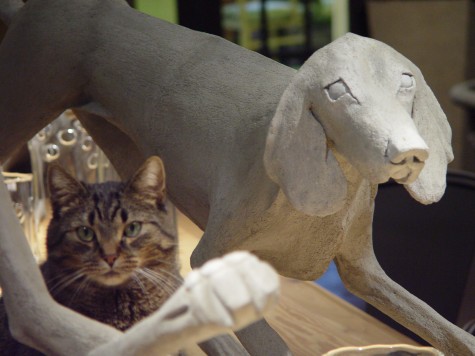
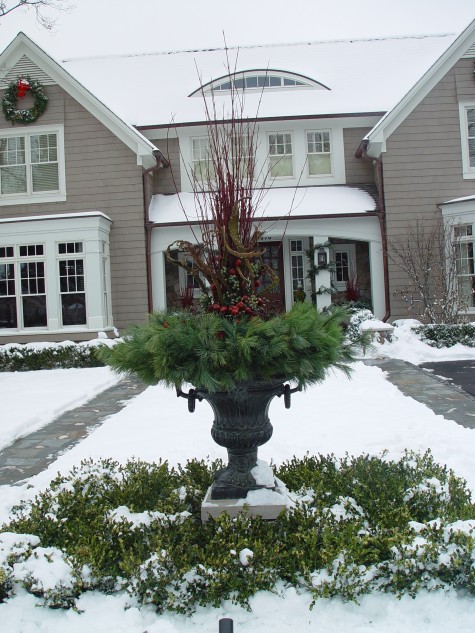
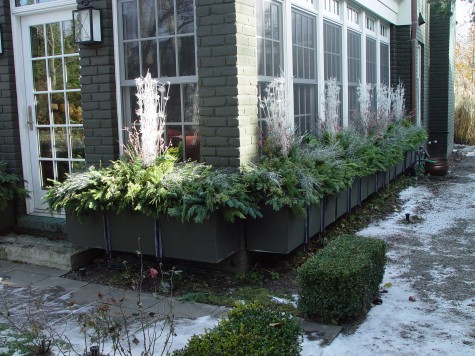 Mixing greens makes it possible to hedge your bet. Cut evergreens are best in cold temperatures; the cold further slows the rate of water evaporation. Though all the cedar species have attractive flat scaly needles, they are the first to dessicate if the late fall takes a warm turn. Their loss of color from evaporation is less noticeable when they have more lively companionship. Mixed greens add textural interest interest in volume. This mix of Douglas fir, white pine, cedar and silver fir illustrates clearly how variable a natural green color can be.
Mixing greens makes it possible to hedge your bet. Cut evergreens are best in cold temperatures; the cold further slows the rate of water evaporation. Though all the cedar species have attractive flat scaly needles, they are the first to dessicate if the late fall takes a warm turn. Their loss of color from evaporation is less noticeable when they have more lively companionship. Mixed greens add textural interest interest in volume. This mix of Douglas fir, white pine, cedar and silver fir illustrates clearly how variable a natural green color can be. 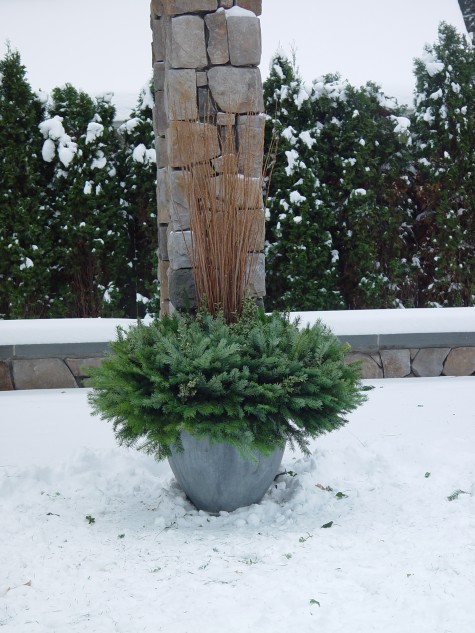 Fir species are instantly identifiable. The needles are arranged in the half round; the branches are flat on their undersides. Douglas fir is one of my favorite evrgreen plants. They will tolerate a little shade, and they are very disease and insect resistant. They are commonly available as Christmas trees; their soft needles make trimming a tree easy on the hands. As cut branches, they are remarkably long lasting. Their bright medium green makes them a good choice for arrangements viewed from far away. It is not unusual for me to clean out winter pots in April where the Douglas fir branches are still green.
Fir species are instantly identifiable. The needles are arranged in the half round; the branches are flat on their undersides. Douglas fir is one of my favorite evrgreen plants. They will tolerate a little shade, and they are very disease and insect resistant. They are commonly available as Christmas trees; their soft needles make trimming a tree easy on the hands. As cut branches, they are remarkably long lasting. Their bright medium green makes them a good choice for arrangements viewed from far away. It is not unusual for me to clean out winter pots in April where the Douglas fir branches are still green. 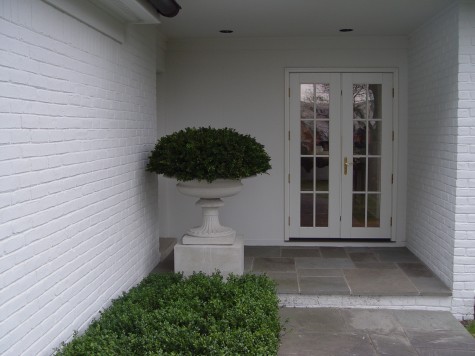
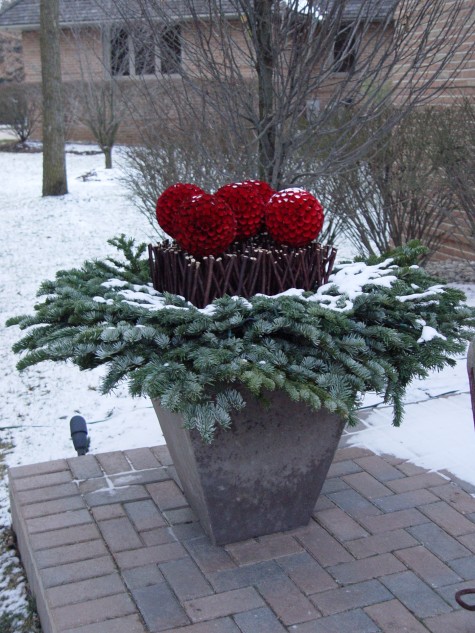 Silver fir branches are an icy blue color; it is all the more attractive paired with red. These spheres are made from giant wood shavings that are dyed red. The color is remarkable stable outdoors; there is little in the way of fading even in full sun. We test any materials we think might go outdoors, to be sure they can withstand wet weather.
Silver fir branches are an icy blue color; it is all the more attractive paired with red. These spheres are made from giant wood shavings that are dyed red. The color is remarkable stable outdoors; there is little in the way of fading even in full sun. We test any materials we think might go outdoors, to be sure they can withstand wet weather. Berried juniper, and noble fir contrast in texture, and compliment one another in color. Natural eucalyptus pods are quite blue, and weather to a soft grey. Chocolate and cream ting stacks complete the ensemble.
Berried juniper, and noble fir contrast in texture, and compliment one another in color. Natural eucalyptus pods are quite blue, and weather to a soft grey. Chocolate and cream ting stacks complete the ensemble.  This dried mood moss is soaked with a spray of moss dye before it goes outdoors. In full sun, this treatment may need to be repeated during the course of the season. The wood dowel trunk of this winter topiary is covered in mountain reed of a color similar to the rusty age on these vintage English painted steel boxes. The top of the box is stuffed with a variegated boxwood known in the florist’s trade as oregonia.
This dried mood moss is soaked with a spray of moss dye before it goes outdoors. In full sun, this treatment may need to be repeated during the course of the season. The wood dowel trunk of this winter topiary is covered in mountain reed of a color similar to the rusty age on these vintage English painted steel boxes. The top of the box is stuffed with a variegated boxwood known in the florist’s trade as oregonia.